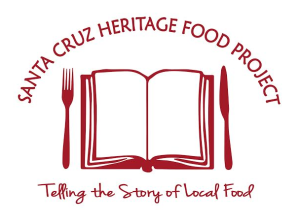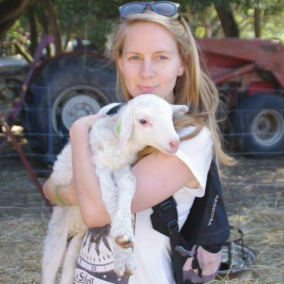Santa Cruz County is a region shaped by an abundant bay, naturally rich soils, an evolving cultural landscape, an economy rooted in natural resources and something that has tied them all together: Food.
The Santa Cruz Heritage Food Project brings all these components together. This project illuminates the history and culture of Santa Cruz County through the lens of food, which opens up stories of history, culture, geography, and taste. We hope to tell a compelling story that can help millennials living here—like ourselves—link to the history of the County in a way that is accessible and delicious. As part of this effort, we are writing a book to share the information we have gathered. This book, expected in Summer 2017, is full of local history and local historical recipes. It is the book we wanted to read, but could not find on the shelves.
The book includes the following crops/foods:
- Wine
- Wheat & Potatoes
- Hops & Beer
- Dairy
- Sugar Beets
- Apples
- Artichokes & Brussels Sprouts
- Berries
- Poultry & Eggs
- Pismo Clams
- Dry-farmed Tomatoes
To explore these foods we are looking at how they got here, who cultivated them, how they were used, and how they were/ are grown and produced. We are also researching economic histories, environmental impacts and interesting stories we discover along the way. We don’t intend to highlight everything we come across – only that which we find fascinating, heartwarming, and a value to the community. The project will include a call for recipes and old family stories and pictures that showcase the diverse ways these foods have been used in Santa Cruz. While many local recipe and history books have been written, we see this as a new opportunity to celebrate our food traditions, and unite education with pleasure.
This project will honor our food heritage and inspire future generations of food stewards
Who We Are
 Jody Biergiel Colclough came to Santa Cruz to participate in the organic food movement. After two years on the East coast earning her MS in Food Science, she hurried back to coastal California. In addition to working as an organic certifier, she has sat on the Board of Slow Food Santa Cruz, and spends as much time procuring, preparing and consuming the foods of the region as she can. She gets to indulge her love of reading and history with the Heritage Food Project.
Jody Biergiel Colclough came to Santa Cruz to participate in the organic food movement. After two years on the East coast earning her MS in Food Science, she hurried back to coastal California. In addition to working as an organic certifier, she has sat on the Board of Slow Food Santa Cruz, and spends as much time procuring, preparing and consuming the foods of the region as she can. She gets to indulge her love of reading and history with the Heritage Food Project.
She is researching sugar beets, dry-farmed tomatoes, and poultry for the Project.
_______________________________________________________________________________________________________________
 Sierra Ryan grew up in Live Oak on land that her family used to farm. After spending six years away to earn her BA and MS, Sierra returned in 2007 ready to become more involved in the community. Her career is focused on water resources, and through that line of work the importance of agriculture – both current and historical – to the region became obvious. While trained as a scientist, Sierra grew up with a love of local history. The Heritage Food Project is an opportunity to explore local history and local agriculture – and indulge in some fine dining at every opportunity.
Sierra Ryan grew up in Live Oak on land that her family used to farm. After spending six years away to earn her BA and MS, Sierra returned in 2007 ready to become more involved in the community. Her career is focused on water resources, and through that line of work the importance of agriculture – both current and historical – to the region became obvious. While trained as a scientist, Sierra grew up with a love of local history. The Heritage Food Project is an opportunity to explore local history and local agriculture – and indulge in some fine dining at every opportunity.
She is researching apples, brussels sprouts, artichokes, & clams for the Project.
_______________________________________________________________________________________________________________
If Liz Birnbaum had a million dollars, she would be doing exactly what she is doing now: living in Santa Cruz, connecting with and working to entertain the community, and biking the coast. Her passion is food, and that has taken the form of food history and community engagement. She works to build community through telling stories about the deeper histories of food through her project, The Curated Feast. She has worked at local organic farming non-profits, on farms, in classrooms, on wilderness trips, and in art galleries through her varied career. She loves funneling some of her energy toward the Heritage Food Project because she keeps finding more stories to unravel.
She is researching wine, wheat, and potatoes for the Project.
_______________________________________________________________________________________________________________
Katie (Lang) Hansen is a dietitian who loves all things related to food. She was formerly on the board of Slow Food Santa Cruz and currently is taking a break from her work in diabetes education to stay at home with her toddler.
She is researching berries for the Project.
_______________________________________________________________________________________________________________
Our History
We are history researchers, but we also have a history as a group. In 2012, Jody Biergiel Colclough and Sierra Ryan founded this project as a way to explore the foods of the region and to share their passion for local food. Sierra was born and raised in Santa Cruz and studies water and wetlands. Jody came to Santa Cruz to participate in the organic food movement.
In 2013, more folks who shared the passion that sparked this venture joined: Liz Birnbaum, Katie Lang, Stephanie Haas, and Jenni Veitch-Olsen came on board to research more crops. Liz was the Chairperson of Slow Food Santa Cruz for 2 years and she has researched and curated several food exhibits, runs The Curated Feast, works to support organic farmers. Katie participated on the Board of Slow Food Santa Cruz, and as a native Santa Cruzan has many local connections to share with the project. Stephanie is an avid home brewer, canner, and blogger. Jenni has graduate level training and university experience in cultural history, is no stranger to archives, public records, historical societies, and brings interviewing experience to the Project.
This project was founded in collaboration with Slow Food Santa Cruz.
Research Venues
We have been greatly helped by a number of local resources, but especially: Ag History Project, the Santa Cruz Public Library, Researchers Anonymous, and the Museum of Art and History.


